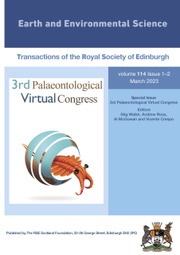Article contents
XX.—The Genus Dictyoconus and its Allies: A Review of the Group, together with a Description of Three New Species from the Lower Eocene Beds of Northern Baluchistan
Published online by Cambridge University Press: 06 July 2012
Abstract
The author recalls the various opinions which have been expressed as to the relationships of Blanckenhorn's genus Dictyoconus to other foraminiferal types. He shows how Dictyoconus has been affiliated to the genera Lituola, Lituonella, and Coskinolina by such authorities as Messrs Schlumberger, Douvillé, and Schubert in the past; but has since been dissociated from them by Professor Cushman in his recent monograph on the Foraminifera. The author then discusses the grounds for this dissociation, which seem to him to be inadequate; and he describes his discovery, in certain Lower Eocene beds of Northern Baluchistan, India, of numerous specimens of Didyoconus, Coskinolina, and Lituonella, mixed indiscriminately together within the same narrow limestone bands, and deceptively similar in external appearance. He describes the differences between these genera—differences which are confined to the peripheral portion of the test—and shows how sections of the three Indian forms reveal the closest agreement in their internal characters as a whole; their generic characters alone affording the means of distinguishing between them. He therefore regards these Indian forms as affording clear evidence of the close affiliation of these three genera. These Indian forms, which are the first representatives of their respective genera to be found so far east, are very similar to such western forms as Dictyoconus egyptiensis (Chapman), Coskinolina liburnica Stache, and Lituonella roberti Schlumberger and Douvillé; but they have individual peculiarities of their own, and so are described by the author as three new species.
- Type
- Research Article
- Information
- Earth and Environmental Science Transactions of The Royal Society of Edinburgh , Volume 56 , Issue 2 , 1930 , pp. 485 - 505
- Copyright
- Copyright © Royal Society of Edinburgh 1930
References
- 16
- Cited by


